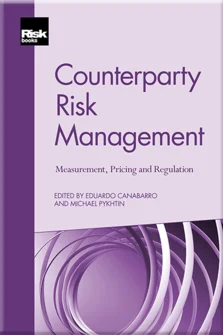Stress Test of Counterparty Risks and Dynamic Hedging of the CVA
The Basel III Enhancements to Counterparty Risk Capital Charges
The Regulation of Counterparty Risk in Over-the-Counter Derivatives Markets
The Non-Internal Model Method for Counterparty Credit Risk
On Credit Valuation Adjustments and Regulatory Capital
American Monte Carlo: A Practitioner Approach
Best Market Practice for Calculation and Reporting of Wrong-Way Risk
Central Counterparty Risk
CVA Risk Management Post-Crisis
Re-Thinking CVA: Valuations, Counterparty Credit Risk and Model Risk
Should Derivatives Dealers Make A Funding Value Adjustment?
Adjoint Algorithmic Differentiation: Real-Time Counterparty Credit Risk Management in Monte Carlo Simulations
Stress Test of Counterparty Risks and Dynamic Hedging of the CVA
Dynamic Stress Testing of Counterparty Default Risk
Collateral: Modelling, Pricing and Optimisation

In this chapter we discuss the design of the stress test for counterparty credit risk (CCR). In particular, we focus on a risk component that has not been addressed directly by the usual stress tests of counterparty risks: the costs incurred by a bank that hedges its credit valuation adjustment (CVA) dynamically. We build a Monte Carlo simulation model to analyse these costs. The results of our model show that a combination of market volatility, market illiquidity, transaction costs and wrong-way risks can lead to CVA hedging costs that are very large and even larger than the full value of the initial CVA. We analyse the interaction between the frequency of the rebalancing of the CVA hedges and the costs and errors of the dynamic hedging strategy. In the presence of transaction costs there is a trade-off between hedging error, which is higher at lower rebalancing frequencies, and transactions costs. Our results can be framed in the context of the literature on option replication with transaction costs, eg, Leland (1985) and Boyle and Vorst (1992).
The chapter is organised as follows: first, we summarise the evolution of the regulatory framework for stress testing, which
Copyright Infopro Digital Limited. All rights reserved.
As outlined in our terms and conditions, https://www.infopro-digital.com/terms-and-conditions/subscriptions/ (point 2.4), printing is limited to a single copy.
If you would like to purchase additional rights please email info@risk.net
Copyright Infopro Digital Limited. All rights reserved.
You may share this content using our article tools. As outlined in our terms and conditions, https://www.infopro-digital.com/terms-and-conditions/subscriptions/ (clause 2.4), an Authorised User may only make one copy of the materials for their own personal use. You must also comply with the restrictions in clause 2.5.
If you would like to purchase additional rights please email info@risk.net











